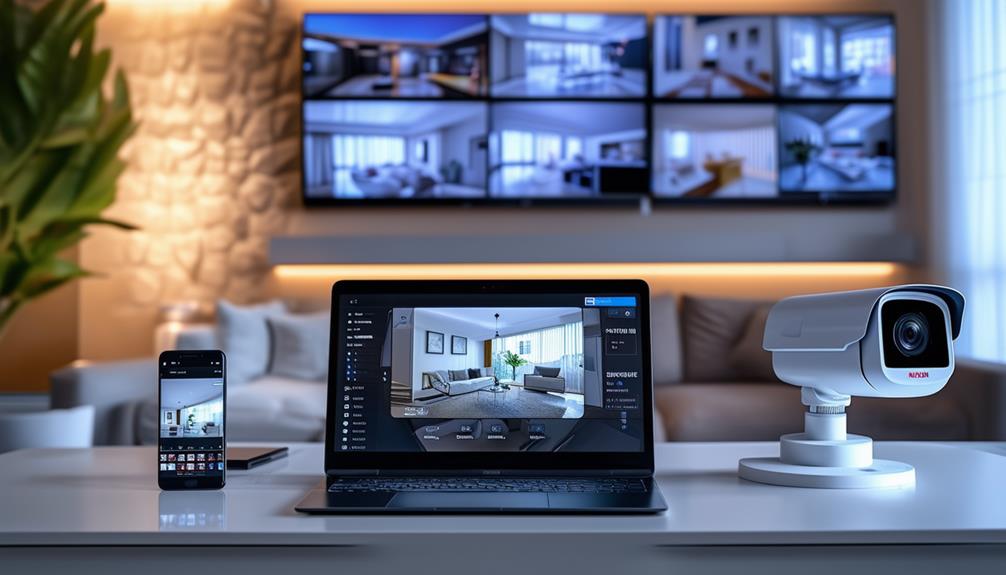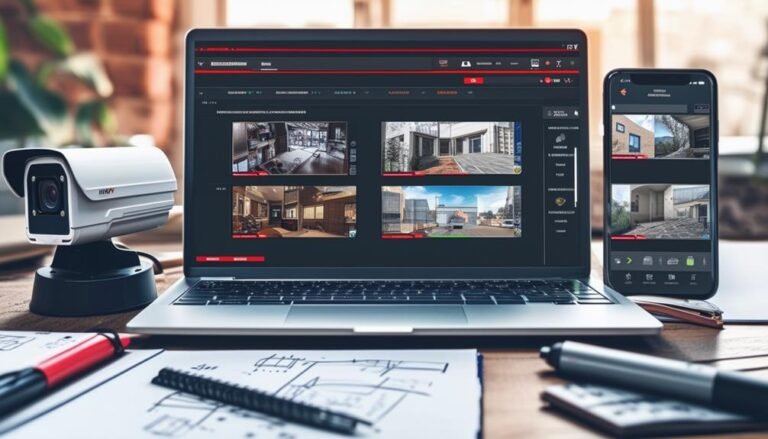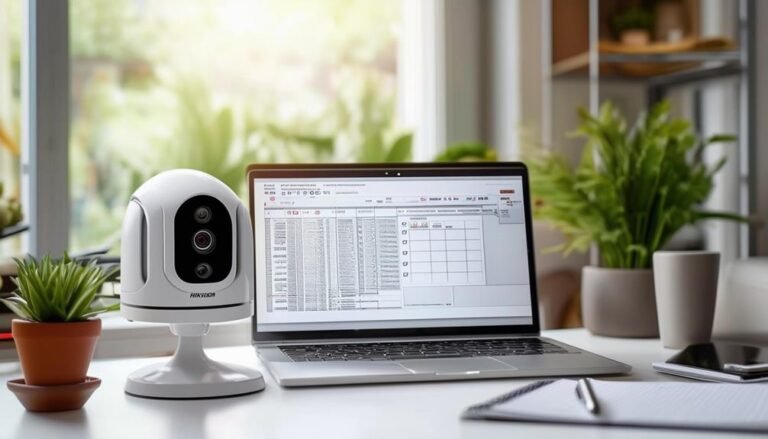To access your Hikvision camera remotely, you'll need a stable internet connection and the Hik-Connect app, which is available for smartphones and tablets. Start by downloading the app and creating an account. Once it's set up, add your camera by scanning its QR code or entering the serial number. You can also access your camera using a web browser by entering the camera's IP address. Verify your camera's firmware is updated and that you're using strong passwords for security. If you're unsure or need more guidance, there's more helpful information out there to assist you.
Understanding Remote Access
When you want to keep an eye on your property from afar, understanding remote access is crucial. It's all about having the freedom to monitor your space wherever you are, whether you're out running errands or on a much-needed vacation. Remote access allows you to view live footage from your Hikvision camera, ensuring you stay connected to your home or business.
First off, you need to grasp the concept of how remote access works. Fundamentally, it involves linking your camera to the internet, enabling you to access the feed through a smartphone, tablet, or computer. This connection means you can check in anytime, ensuring peace of mind without being physically present.
You'll often hear about apps and web interfaces that facilitate this connection. These tools empower you to navigate your camera settings, view live streams, and even review recordings from wherever you are. The convenience of remote access means you're not tied down to your location; instead, you can seize the freedom to manage your security on your terms.
Moreover, remote access isn't just about monitoring; it's about taking action. If you spot something unusual, you can respond quickly, whether that means alerting authorities or addressing the situation directly. In a world where freedom and security go hand in hand, understanding remote access is a crucial step towards safeguarding what matters most to you.
Requirements for Remote Access
To access your Hikvision camera remotely, you'll need to meet certain requirements that guarantee a smooth connection. First off, make certain you have a reliable internet connection. Whether you're using Wi-Fi or a wired Ethernet connection, stability is key. A strong signal boosts your ability to view live feeds without interruptions, giving you the freedom to monitor your space anytime, anywhere.
Next, you'll need a compatible device. This could be a smartphone, tablet, or computer. Ensure it's equipped with the necessary apps or software to connect to your camera. Hikvision provides its own app, which is user-friendly and designed specifically for mobile devices. It allows you to access your camera with just a few taps.
You'll also want to check that your camera's firmware is up to date. Regular updates often include security patches and enhancements that improve remote access. Don't forget to set up a strong password for your camera, as security is vital for remote access. Weak passwords can jeopardize your privacy and defeat the purpose of monitoring your property.
Lastly, verify that your camera supports remote access features. Most modern Hikvision models do, but it's always good to confirm. With these requirements in place, you'll be well-equipped to enjoy the freedom of accessing your camera remotely, providing peace of mind no matter where you are.
Configuring Your Hikvision Camera
Configuring your Hikvision camera is vital for guaranteeing peak performance and security. To get started, you'll want to access the camera's settings via its web interface. Here's a quick overview of the key configuration steps you should follow:
| Configuration Step | Description |
|---|---|
| Network Settings | Set up your IP address, subnet mask, and gateway to guarantee connectivity. |
| User Management | Create user accounts and set permissions for secure access to the camera. |
| Video Settings | Adjust resolution, frame rate, and bit rate to optimize video quality and bandwidth usage. |
First, connect your camera to the network and use a web browser to enter the camera's IP address. You'll need to log in with the default username and password unless you've changed them. Once inside the interface, adjust the network settings to match your local network configuration.
Next, manage user accounts by adding specific users and assigning them appropriate access levels. This step is vital for maintaining privacy and security.
Setting Up a Dynamic DNS
When you're trying to access your Hikvision camera remotely, using Dynamic DNS can make things a lot easier. It helps you manage changing IP addresses so you can always connect without hassle. Let's explore why you should use Dynamic DNS, how to choose a service provider, and the steps to configure your camera settings.
Why Use Dynamic DNS?
Dynamic DNS (DDNS) offers a practical solution for managing remote access to your Hikvision camera, especially if your internet service provider frequently changes your IP address. Instead of trying to remember a constantly changing IP, DDNS lets you use a domain name that you can access easily. This means you can log into your camera from anywhere without worrying about whether your IP has changed.
By setting up DDNS, you're taking control of your remote surveillance. You won't miss important events just because you can't find your camera's address. It keeps your connection stable and reliable, giving you peace of mind.
Moreover, it's a cost-effective way to maintain access without needing a static IP address, which can often come with additional fees. You're empowering yourself to manage your security effortlessly, whether you're at home or on the move.
In a world where you value your freedom and independence, having the ability to monitor your surroundings seamlessly is essential. So, consider setting up DDNS to guarantee you always have access to your Hikvision camera, no matter where life takes you.
Choosing a Service Provider
Choosing the right Dynamic DNS service provider can make all the difference in your remote access experience with your Hikvision camera. You want a service that's reliable, easy to use, and offers features that align with your needs. Look for providers that support multiple platforms and devices, ensuring compatibility with your camera setup.
Consider the cost, too. Some providers offer free services, while others may charge a fee. Weigh the pros and cons; sometimes, a paid service provides better support and features, giving you peace of mind.
Also, check the provider's uptime history and customer reviews. A service with a strong reputation for reliability will help you maintain consistent access to your camera, no matter where you are.
Lastly, think about ease of setup. A user-friendly interface can save you time and frustration. You should feel empowered, not hindered, by the technology you choose.
Configuring Hikvision Settings
Setting up a Dynamic DNS for your Hikvision camera is crucial for maintaining remote access without the hassle of constantly changing IP addresses. To get started, you'll first want to choose a Dynamic DNS service that suits your needs. Once you've registered for an account, log into your Hikvision camera's web interface.
Navigate to the "Network" section, then click on "DDNS." Here, you'll see options to enter your Dynamic DNS provider's details. Fill in the hostname you registered, along with your username and password. Be certain to select the correct service type from the dropdown menu.
Next, you can test the connection to verify everything's working smoothly. If successful, your camera will now update its IP address dynamically, allowing you to access it remotely anytime, anywhere.
Don't forget to save your settings! Regularly check that your Dynamic DNS service is functioning correctly, as it's your gateway to surveillance freedom. With your camera properly configured, you can enjoy peace of mind knowing you can monitor your property without the constant worry of IP changes.
Using the Hik-Connect App
Accessing your Hikvision camera remotely has never been easier, especially with the Hik-Connect app at your fingertips. This powerful tool lets you take control of your security system from anywhere, giving you the freedom to monitor your property on the go. With just a few taps, you can keep an eye on what matters most.
Here's how to get started with the Hik-Connect app:
- Download the App: Head to your device's app store and grab the Hik-Connect app. It's available for both iOS and Android, so you can use it on any smartphone.
- Create an Account: Open the app and sign up for a new account. You'll need to verify your email address, but once that's done, you're one step closer to seamless entry.
- Add Your Camera: Within the app, tap "Add Device." You can either scan the QR code on your camera or enter its serial number manually. This connects your camera to the app, enabling remote viewing.
- Start Monitoring: Once your camera is added, you can view live feeds, receive alerts, and even playback recorded footage anytime you want. It's like having a personal security guard in your pocket!
With the Hik-Connect app, you're empowered to manage your security effortlessly, ensuring peace of mind no matter where life takes you. So go ahead, embrace the freedom of remote access!
Accessing via Web Browser
When accessing your Hikvision camera via a web browser, you'll need to make sure your browser is compatible with the camera's interface. You'll also need to know your camera's IP address and have the correct login credentials handy. Once you've got those sorted, you can easily view your camera feed online.
Browser Compatibility Requirements
To successfully view your Hikvision camera remotely through a web browser, it's crucial to guarantee that your browser meets specific compatibility requirements. The right setup not only enhances your experience but also assures smooth access to your security feeds. Here are four key points to keep in mind:
- Browser Type: Use supported browsers like Google Chrome, Mozilla Firefox, or Microsoft Edge. These options are often the most reliable for compatibility.
- Version: Confirm your browser is updated to the latest version. Outdated versions can lead to performance issues and security vulnerabilities.
- Enable Plugins: Some Hikvision features might require browser plugins. Make sure these are enabled and allowed for your camera's URL.
- JavaScript Support: Verify that JavaScript is enabled in your browser settings. Many web functionalities depend on it for seamless operation.
Camera IP Address
Getting the correct IP address for your Hikvision camera is essential for accessing it through a web browser. This unique identifier allows you to connect directly to your camera, giving you the freedom to monitor your property from anywhere. To find the IP address, you can use the Hikvision SADP tool, which scans your network for devices and displays their IP addresses. If you prefer, you can also check your router's connected devices list, where your camera should appear.
Once you've located the IP address, you'll need to enter it into your web browser's address bar. Make sure you're on the same network as your camera, so the connection is seamless. It's vital to type the address correctly; otherwise, you won't be able to access your camera. After entering the IP address, hit Enter, and you should be directed to the camera's web interface.
Login Credentials Needed
Accessing your Hikvision camera requires the right login credentials, which typically include a username and password. Without these, your freedom to monitor your space remotely is secured away. Here's what you'll need:
- Username: This is usually set to "admin" by default but can be customized for added security.
- Password: You'll need the password you chose during setup. If you haven't changed it, the default might still apply.
- Camera IP Address: Remember, this is the unique address your camera uses on the network, essential for accessing it.
- Web Browser: A reliable web browser like Chrome or Firefox will help guarantee a smooth experience when logging in.
Once you have these credentials handy, you can enter them into your web browser to access the full potential of your Hikvision camera. With the right setup, you'll gain the freedom to monitor your property from anywhere, providing peace of mind that's just a click away. So, make certain you've got everything ready, and enjoy the control at your fingertips!
Troubleshooting Connection Issues
When you're trying to connect to your Hikvision camera remotely, you might run into a few hiccups along the way. First, check your internet connection. If your Wi-Fi is spotty or your router's acting up, that could be the culprit. Make certain both your camera and the device you're using are connected to the internet. If you're using a mobile app, try switching between Wi-Fi and cellular data to see if that resolves the issue.
Next, verify your camera's IP address hasn't changed. If you're using DHCP, your camera might get a different IP every time it connects. You can fix this by setting a static IP address for your camera. Also, verify that you've entered the correct credentials. A simple typo can lock you out, so double-check your username and password.
Firewall settings can also block your connection. If you're accessing your camera from a network with strict firewall rules, you may need to adjust those settings or consult your network admin. Finally, if you're using a Dynamic DNS service, confirm it's properly configured. Sometimes, the DDNS server can have issues that prevent access.
If you've gone through all these steps and still can't connect, consider restarting both your camera and router. A quick reboot can often clear up lingering connection issues. With a little patience and troubleshooting, you'll be able to regain access and enjoy the freedom of monitoring your space remotely.
Enhancing Security Measures
To keep your Hikvision camera secure, it's important to implement robust security measures. After all, you want the freedom to monitor your space without worrying about unauthorized access. Here's how you can enhance your camera's security:
- Change Default Passwords: The first step is to change the default password to something strong and unique. Avoid common phrases or easily guessed combinations, opting for a mix of letters, numbers, and symbols.
- Enable Two-Factor Authentication (2FA): Whenever possible, activate 2FA for an extra layer of security. This means even if someone gets hold of your password, they'll need a second authentication method to access your camera.
- Regular Firmware Updates: Keep your camera's firmware up to date. Manufacturers often release updates to patch vulnerabilities. By staying current, you're safeguarding your device against potential exploits.
- Use a Secure Network: Make sure your camera is connected to a secure Wi-Fi network. Avoid using public networks for remote access, as these can be easily compromised. Opt for a strong, encrypted connection instead.
Tips for Remote Monitoring
With your Hikvision camera secured, you can focus on effective remote monitoring. To truly harness the power of your camera, you'll want to maximize your viewing experience and guarantee you're getting the most out of your setup. Start by downloading the Hik-Connect app on your smartphone. This app offers seamless access to your camera feed, allowing you to monitor your property from anywhere, anytime.
Next, consider adjusting the camera's settings. Fine-tuning the resolution and frame rate can enhance your viewing quality while optimizing bandwidth usage. If your connection is unstable, lowering these settings can prevent lag during critical moments.
Don't forget the importance of alerts! Enable motion detection notifications to stay informed of any unusual activity. These alerts can give you peace of mind, letting you respond quickly if something's amiss.
Regularly check your camera's firmware for updates. Staying current guarantees you benefit from enhanced features and security improvements, keeping your surveillance system as effective as possible.
Lastly, create a routine for reviewing your recordings. Setting aside time to analyze footage can help you spot patterns or identify potential vulnerabilities in your security setup.
Frequently Asked Questions
Can I Access My Hikvision Camera Without Internet?
Imagine a bird trapped in a cage, yearning for the open sky. If you're wondering about accessing your Hikvision camera without internet, the freedom you seek is limited. You can still connect directly via a local network, like a tethered connection. However, true remote access, which releases your surveillance capabilities, requires internet connectivity. Embrace the digital winds, and you'll soar far beyond your immediate surroundings.
What Devices Support Hikvision Remote Access?
You'll find that a variety of devices support Hikvision remote access, giving you the freedom to monitor your camera wherever you are. Smartphones and tablets running iOS or Android are great options, as well as PCs and laptops with Windows or MacOS. Additionally, smart TVs with compatible apps can also connect. Each device offers you flexibility in staying connected to your camera, ensuring you're never out of touch with what matters.
How Do I Change My Hikvision Camera Password?
Changing your Hikvision camera password is like unsealing a treasure chest of security. To do this, you'll want to log in to your camera's web interface. Navigate to the settings menu, find the user management section, and select your account. You can then enter a new password. Remember to keep it strong and unique, as it's your key to freedom from unwanted access. Don't forget to save your changes before exiting!
Is There a Mobile Version of the Web Interface?
Yes, there's a mobile version of the web interface for your Hikvision camera. You can access it through your smartphone's browser, allowing you to monitor your camera on the go. Just make sure your camera's settings are configured for mobile access. It gives you the freedom to check in anytime, anywhere, ensuring you stay connected to your security system without being tied to a desktop. Enjoy that flexibility!
How Can I Update My Hikvision Camera Firmware Remotely?
To update your Hikvision camera firmware remotely, you'll need to log into the device's web interface. Once you're in, navigate to the "Configuration" section and look for "Firmware Upgrade." You'll find an option to upload the new firmware file. Make sure you've downloaded the latest version from the Hikvision website. After uploading, confirm the upgrade, and your camera will reboot with the new firmware, enhancing its performance and features.



